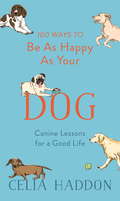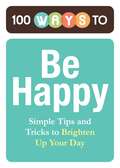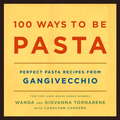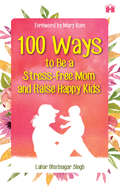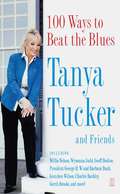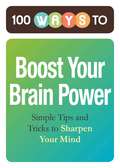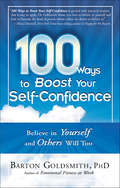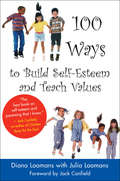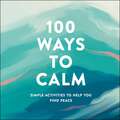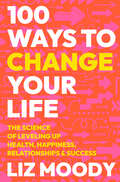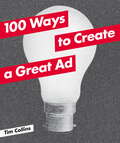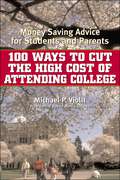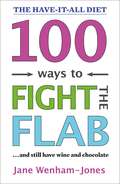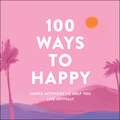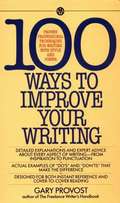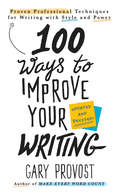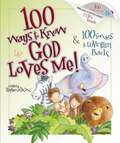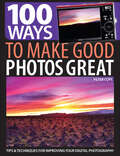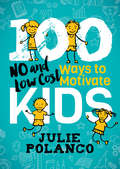- Table View
- List View
100 Ways to Be As Happy As Your Dog
by Celia HaddonIn 100 Ways to Be As Happy As Your Dog, animal behaviour expert Celia Haddon shows you 100 ways in which you, too, can master the art of being happy by learning from your favourite canine companions. Curious, affectionate and always full of energy, dogs have always been a source of joy for us no matter what we are going through in life. Whether you've got a Labrador, a poodle or a shih tzu, your dog is always there, ready to play fetch or offer a cuddle or go for long walks on the beach when you need it. So let animal behaviour expert and bestselling author Celia Haddon show you how you, too, can live a good life as a human by learning the art of happiness from our best animal friend.
100 Ways to Be Happy: Simple Tips and Tricks to Brighten Up Your Day
by Adams MediaBecoming happier is easier than you think!Here at your fingertips are dozens of different ideas on how to enjoy each and every day. With 100 Ways to Be Happy as your guide, things are going to get a little brighter, a little lighter, and a whole lot more fun. From going for a walk on your lunch break to allowing yourself ten minutes just to daydream, these hundred simple tips will certainly put a smile on your face.
100 Ways to Be More Like Your Cat: Feline Wisdom for Happy Humans
by Celia HaddonFrom the bestselling author of One Hundred Ways For a Cat To Train Its Human comes a new guide on how to improve your own life by learning from your cat.Content, living in the moment, finding pleasure in small things - your cat knows exactly how to get the best out of life. So let your cat be your guru as Celia Haddon shows in 100 ways how adopting their outlook can lead to our own happiness. Stretch out, relax, find a warm spot - and enjoy purrfection.
100 Ways to Be More Like Your Cat: Feline Wisdom for Happy Humans
by Celia HaddonFrom the bestselling author of One Hundred Ways For a Cat To Train Its Human comes a new guide on how to improve your own life by learning from your cat.Content, living in the moment, finding pleasure in small things - your cat knows exactly how to get the best out of life. So let your cat be your guru as Celia Haddon shows in 100 ways how adopting their outlook can lead to our own happiness. Stretch out, relax, find a warm spot - and enjoy purrfection.
100 Ways to Be Pasta
by Wanda Tornabene Giovanna TornabeneFor us, pasta is more than just a food. It is part of our histories. It is a good friend, a member of the family. It is something we love . . . When Italians offer a plate of pasta to friends or strangers, we are opening the doors of our homes and welcoming them inside in the most generous way. It is in that spirit that my mamma and I, who have had the good fortune to be accompanied all our lives by this most versatile of foods, invite you through the tall, ancient wooden doors of Gangivecchio and offer up these recipes, these one hundred versions of the golden strands, the god, pasta, to you. So put the water on to boil. And buon appetito! --Giovanna Tornabene, from her IntroductionWelcome back to Gangivecchio, where Wanda and Giovanna Tornabene, two-time James Beard Award winners and beloved doyennes of the Italian kitchen, have served up another irresistible helping of charm, wit, and culinary wisdom from the kitchen of the thirteenth-century abbey they call home. This time around, the dynamic mother-daughter duo takes us back to Sicilian basics, in a recipe-filled compendium and heartfelt tribute to the "queen of the Italian table"--pasta.In 100 Ways to Be Pasta the Tornabenes once again weave memoir and history together with the vivid flavors of local village life, bringing us a true taste of Sicilian culture and cuisine. They incorporate lessons from basic pasta-cooking techniques to secret tips from old masters, and include an extensive glossary of pasta vocabulary, a dictionary of pasta types, and of course a generous sprinkling of anecdotes and advice.All of this serves as a delightful setting for the one hundred authentic, mouth-watering recipes, lovingly honed and perfected in the old abbey kitchen. From quick, easy basics, like spaghetti with garlic, oil, and hot pepper or farfalle with peas and prosciutto, to traditional pasta soups like minestrone, to more elaborate baked and stuffed pastas like Baked Orecchiette with Lamb Ragù and Melted Mozzarella or Baked Timbale of Anelletti with Veal and Vegetables, each recipe serves up a little piece of Sicily for your very own kitchen.As informative and useful to the beginner as to the experienced Italian cook, 100 Ways to Be Pasta is a must-have and a treasure for any cookbook shelf.From the Hardcover edition.
100 Ways to Be a Stress-free Mom and Raise Happy Kids
by Lahar Bhatnagar Singh100 Ways to Be A Stress-Free Mom and Raise Happy Kids explores motherhood in a brand-new light. The author draws from her neuroscience background and her analysis of hundreds of real parents and takes you directly to the core of what it truly means to be a mother . . . without sugar coating it.Each chapter presents a real-world parenting scenario with the most accurate and up-to-date advice on how to sail through it in the most efficient way possible. With chapters such as ‘Have a Ranting Bestie’ and ‘Take Your Baby to Hard Rock Cafe’, this a must-have book for all present-day mothers who want to transform into a Nirvana-ma: a happy, peaceful, and stress-free mom!
100 Ways to Beat the Blues
by Tanya TuckerHow do you beat the blues? We all have moments in life when we're down, lonely, or just plain sad. It's part of being human. Just as everyone is different, everyone has a unique way of beating the blues. For anyone who needs a bit of inspiration, a smile, or a friendly pat on the back, Tanya Tucker and ninety-nine friends offer this heartwarming collection of their personal recipes for beating the blues. President George H.W. Bush yells at the television. Loretta Lynn makes herself a fried bologna sandwich. Sir Arthur C. Clarke explores the infinite universe of fractals. NASCAR's Geoff Bodine cleans the house. Seventy celebrities such as Kris Kristofferson, Wynonna Judd, and Garth Brooks and thirty ordinary folks such as a farmer, a private detective, a doctor, and a retired gospel radio-show host share what lifts their spirits and remind us of all the joy life has to offer.
100 Ways to Boost Your Brain Power: Simple Tips and Tricks to Sharpen Your Mind
by Adams MediaBecoming happier is easier than you think!Here at your fingertips are dozens of different ideas on how to enjoy each and every day. With 100 Ways to Be Happy as your guide, things are going to get a little brighter, a little lighter, and a whole lot more fun. From going for a walk on your lunch break to allowing yourself ten minutes just to daydream, these hundred simple tips will certainly put a smile on your face.
100 Ways to Boost Your Metabolism: Simple Tips and Tricks to Burn Fat and Fuel Your Body
by Adams MediaBecoming happier is easier than you think!Here at your fingertips are dozens of different ideas on how to enjoy each and every day. With 100 Ways to Be Happy as your guide, things are going to get a little brighter, a little lighter, and a whole lot more fun. From going for a walk on your lunch break to allowing yourself ten minutes just to daydream, these hundred simple tips will certainly put a smile on your face.
100 Ways to Boost Your Self-Confidence: Believe In Yourself and Others Will Too (100 Ways Series)
by Barton GoldsmithWhen you don't believe in yourself, everything is more difficult. 100 Ways to Boost Your Self-Confidence will literally help you change your life by changing the way you feel about yourself. Not only will you have faith in who you really are, but the people you love and work with will believe in you as well.100 Ways to Boost Your Self-Confidence will show you how to: Discover the essence of your personal power and belief in yourself.Create the life you want with practical "feel good" behaviors.Reduce your doubts, increase your self-worth and make your world a better place.Improve the quality of your relationships by changing the way you think about yourself and how others think about you.Become your best self by employing these easy-to-use techniques.
100 Ways to Build Self-Esteem and Teach Values
by Diana LoomansMother-and-daughter team Diana and Julia Loomans offer 100 creative ideas, techniques, and processes for making day-to-day family interactions easier and more joyful. Based on the principle that respecting -- not controlling -- children is key to building self-esteem, the activities in this book promote love, self-worth, and connection between parent and child. 101 Ways to Build Self-Esteem and Teach Values offers an encyclopedia of hands-on exercises, charts, heartwarming stories, poetry, and quotations to help parents and children learn basic tools for cultivating mutual respect, recognition, and independence.
100 Ways to Calm: Simple Activities to Help You Find Peace (100 Ways Ser.)
by Adams MediaBring peace, serenity, and tranquility to your life with these 100 activities and exercises to stay calm no matter what comes your way!In the chaos of everyday life, staying relaxed isn&’t always easy. But learning to remain calm is a skill that everyone can master if you have the right tools. In 100 Ways to Calm, you will find 100 activities, quotes, thought exercises, and more to help you stay calm when you need it most. From learning simple and easy breathing exercises to going for a walk or filling in a journal, this practical book has a recommended method for everyone!
100 Ways to Change Your Life: The Science of Leveling Up Health, Happiness, Relationships & Success
by Liz MoodyFrom the creator of The Liz Moody Podcast comes a science-backed guide to creating your best life.What daily habits do happiness psychologists recommend to sprinkle our lives with joy? What does the latest research show about how we can live longer? How do the world’s top gastroenterologists tackle bloating and constipation? How can we amp up our charisma, make and keep quality friendships, and overcome the burn out sapping our energy every day?100 Ways to Change Your Life offers real answers to each of these questions, and so many more. This is a new kind of personal growth book; here, veteran journalist Liz Moody translates her years of experience interviewing the world’s leading doctors, scientists, and thinkers into a smart, choose-your-own-adventure-style read that offers concrete solutions to some of life’s biggest hurdles—physical, mental, emotional, or otherwise. Whether you decide to read the entire book at once for total transformation, a tip a day to add a dose of inspiration to your morning routine, or go directly to the sections that address your specific needs and challenges, every page of 100 Ways to Change Your Life offers powerful, habit-building tips across subjects ranging from mental health, careers, relationships, confidence, and physical health in 100 fun-to-read, easy-to-digest parts that provide highly actionable tools and mindset-shifting ideas that will change every part of your life—from the moment you turn the first page.
100 Ways to Create a Great Ad
by Tim Collins100 Ways to Create a Great Ad is an accessible introduction to creative advertising techniques. Featuring 100 spreads detailing concepts such as the "Reveal" and the "Mash-up", it presents the key methods of devising print, television, radio, direct, and online ideas. The process of creating an ad can be divided into three steps: planning; concept creation; crafting. This book provides a straightforward guide to concept creation, including methods that are applicable across media and offering wide-ranging examples from international campaigns. Aimed at agency creatives, planners, and account handlers, as well as graphic designers, marketing professionals, and students, 100 Ways to Create a Great Ad has wide-ranging appeal.
100 Ways to Create a Great Ad
by Tim Collins100 Ways to Create a Great Ad is an accessible introduction to creative advertising techniques. Featuring 100 spreads detailing concepts such as the "Reveal" and the "Mash-up", it presents the key methods of devising print, television, radio, direct, and online ideas. The process of creating an ad can be divided into three steps: planning; concept creation; crafting. This book provides a straightforward guide to concept creation, including methods that are applicable across media and offering wide-ranging examples from international campaigns. Aimed at agency creatives, planners, and account handlers, as well as graphic designers, marketing professionals, and students, 100 Ways to Create a Great Ad has wide-ranging appeal.
100 Ways to Cut the High Cost of Attending College: Money-Saving Advice for Students and Parents
by Michael P. Viollt100 Ways to Cut the High Cost of Attending College goes beyond giving information on college scholarships and financial aid programs. Viollt's book spells out in a clear, concise, workbook format many different ways that students can reduce tuition costs and living expenses, and get the maximum benefits for their money. Examples of Viollt's recommendations include transferring from community college, establishing in-state residency, obtaining federal grants and loans, working for colleges in exchange for stipends or free housing, using employers and military service to help in getting a college degree, and graduating in a timely fashion without having to pay for extra semesters. Also included are rankings of colleges and profiles of students that show these tips put into practice.The skyrocketing costs of college tuitions-which generally increase at twice the rate of inflation-have led families with comfortable incomes to explore ways to keep education costs manageable. For those who don't qualify for need-based financial aid but still find the cost of college to be daunting, Viollt's guide provides excellent insights on staying within a reasonable budget while getting a useful and comprehensive education.
100 Ways to Fight the Flab
by Jane Wenham-JonesAn epic novel of an incendiary love that threatened to set the desert alight as war raged between the British and Ottoman Empires. Mesopotamia, 1914: in the Middle East tension is escalating between the British and the Arabs. Misfit Lieutenant Harry Downe is sent to negotiate a treaty with a renegade Bedouin Sheikh, Ibn Shalan, whose tribe is attacking enemy patrols in Iraq and cutting their oil pipelines. Greedy for arms, Shalan accepts British weapons but, in return, Harry must take his daughter Furja to be his bride. The secret marriage leads to a deep love, to the anger of Shalan and the disgust of Harry's fellow officers. But war is looming, and the horrors of the battlefield threaten to destroy Harry's newfound happiness, and change his life and that of his closest friends for ever. Long Road to Baghdad is a vivid, moving, historically accurate account of a conflict between East and Western Empires, based on the wartime exploits of war hero Lieutenant Colonel Gerard Leachman.
100 Ways to Fight the Flab: The Have-it-all Diet
by Jane Wenham-Jones'Sane and sensible - and very funny.' Marina O'LoughlinEver started a new diet and found yourself reaching for the wine and chocolate within a week? Well now you can! Jane Wenham-Jones, best-selling author and columnist, offers 100 tips on slimming down without sacrifice.Quirky but useful, fun but factual, Jane's approach is a unique mixture of everyday science, the right mental attitude, and common-sense strategies, designed to fit in with your busy life. With advice on "party weeks", dressing to hide the pounds, and how to lose weight fast when a big date looms, Jane offers tactics that work where most diets fail. From eating a chilli a day to speed up your metabolism, to doing quick bursts of exercise with rapid results, to simply thinking yourself skinnier, these tried-and-tested methods will see you leaner and fitter - while allowing for a daily fix of the foods you love.
100 Ways to Happy: Simple Activities to Help You Live Joyfully (100 Ways Ser.)
by Adams MediaBrighten your day and bring happiness to your life with these 100 simple activities and exercises to find joy whenever you need it most.Finding happiness when times are tough can be difficult, but it is possible—all you need to do is practice and find the right tools that work for you! In 100 Ways to Happy, you will discover 100 activities, quotes, thought exercises, and more to bring happiness to your life whenever you need it most. From creating a vision board to partaking in joyful meditation, this beautiful and practical guide has a method for everyone to try. Never let life get you down again with these simple, effective ways to live more joyfully.
100 Ways to Improve Your Sex Life: Simple Tips and Tricks to Spice Things Up
by Adams MediaMaking your life a little sexier is easier than you thinkHere at your fingertips are dozens of different ideas on how to turn up the heat in (and out of) the bedroom. With 100 Ways to Improve Your Sex Life as your guide, things are going to get a little kinkier, a little steamier, and a whole lot more fun. From teasing your partner with sexy texts to exploring new erogenous zones, these hundred simple tips will certainly keep things interesting.
100 Ways to Improve Your Writing
by Gary ProvostThis is the one guide that anyone who writes--whether student, business person, or professional writer--should put on the desk beside pencil, pen, typewriter, or word processor. Filled with professional tips and a wealth of instructive examples, this valuable, easy-to-use handbook can help you solve any and all writing problems. <P><P> Advisory: Bookshare has learned that this book offers only partial accessibility. We have kept it in the collection because it is useful for some of our members. To explore further access options with us, please contact us through the Book Quality link on the right sidebar. Benetech is actively working on projects to improve accessibility issues such as these.
100 Ways to Improve Your Writing (Updated): Proven Professional Techniques for Writing with Style and Power
by Gary ProvostThe classic text on writing well, now refreshed and updated.This is the one guide that anyone who writes—whether student, businessperson, or professional writer—should keep on his or her desk. Filled with professional tips and a wealth of instructive examples, 100 Ways to Improve Your Writing can help solve any writing problem. In this compact, easy-to-use volume you'll find the eternal building blocks of good writing—from grammar and punctuation to topic sentences—as well as advice on challenges such as writer's block and creating a strong title. It is a must-have resource—perfect for reading cover to cover, or just for keeping on hand for instant reference—now updated and refreshed for the first time.
100 Ways to Know God Loves Me, 100 Songs to Love Him Back
by Stephen ElkinsWhat better combination than 100 ways for young children to learn how much God loves them and 100 songs they can sing to show how much they love him back?This easy-to-read text and colorful art will have children eager to find out how much God loves them and to sing their loving praise back to God. Stories include: God Answers My Prayers, God Calms Me When I'm Worried, God Helps Me Make Good Choices, and God Gave Me a Family. Familiar Bible verses tell of God's promises and encourage little ones to thank Him for His great love. This is a great resource to help kids memorize 100 Bible verses. Includes 2 CDs with 100 songs written and recorded by Grammy-nominated producer, Stephen Elkins.
100 Ways to Make Good Photos Great: Tips & Techniques for Improving Your Digital Photography
by Peter CopeA practical, accessible guide to turning your good photographs into great ones whether you are shooting on the latest digital SLR or a camera phone. Discover one hundred simple and fun ways to improve your photographs both in-camera and through post-processing image manipulation. Every key photographic genre is covered, from perfect portraits and the great outdoors, to travel photos and shooting at night. Filled with inspirational examples of great photographs compared against the more average images, with easy-to-follow techniques for how you can achieve the same results. Whether you are an aspirational amateur wanting to make your photographs even better, or an enthusiastic beginner who just wants to produce more satisfying results, 100 Ways to Make Good Photographs Great will provide you with useful professional tips and techniques to take your photography to the next level.
100 Ways to Motivate Kids: No And Low Cost
by Julie PolancoThis guide offers one hundred free or low-cost educational activities that inspire children age six and up to explore the world God made. 100 Ways to Motivate Kids offers challenging projects and activities for children ages six through eighteen to engage with the world in relevant, creative, faith-based, and educational ways. Dividing this guide by age group and subject area—covering math, nature, world cultures, and more—Julie Polanco includes fresh ideas that help develop twenty-first century skills through fun, developmentally appropriate experiences. In addition, 100 Ways encourages community involvement, a love for the environment, and an entrepreneurial spirit. There is no need to buy expensive kits or subscriptions because this pocket-sized book covers the same STEAM principles (Science, Technology, Engineering, Arts, and Math) at a fraction of the cost—and includes the humanities.
